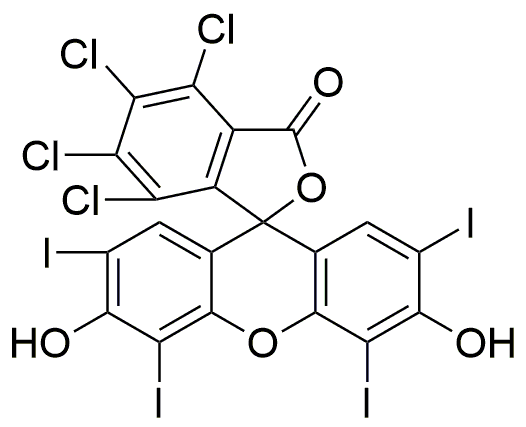Rose Bengal lactone is widely utilized in research focused on:
- Photodynamic Therapy: This compound is used in medical treatments for certain types of cancer. Its ability to generate reactive oxygen species upon light activation makes it effective in targeting and destroying cancer cells while minimizing damage to surrounding healthy tissue.
- Fluorescent Tracers: In biological research, Rose Bengal lactone serves as a fluorescent dye. It is commonly used in microscopy to label cells and tissues, allowing researchers to visualize and track biological processes in real-time.
- Environmental Monitoring: The compound is applied in assessing water quality. It can be used to detect and quantify pollutants, providing valuable data for environmental scientists working to maintain ecosystem health.
- Antimicrobial Applications: Rose Bengal lactone exhibits antimicrobial properties, making it useful in the development of disinfectants and antiseptics. This application is particularly relevant in healthcare settings where infection control is critical.
- Research in Photochemistry: The compound is a valuable tool in photochemical studies, helping scientists explore light-induced chemical reactions. Its unique properties facilitate the understanding of complex photochemical processes.
Información general
Propiedades
Seguridad y normativas
Aplicaciones
Rose Bengal lactone is widely utilized in research focused on:
- Photodynamic Therapy: This compound is used in medical treatments for certain types of cancer. Its ability to generate reactive oxygen species upon light activation makes it effective in targeting and destroying cancer cells while minimizing damage to surrounding healthy tissue.
- Fluorescent Tracers: In biological research, Rose Bengal lactone serves as a fluorescent dye. It is commonly used in microscopy to label cells and tissues, allowing researchers to visualize and track biological processes in real-time.
- Environmental Monitoring: The compound is applied in assessing water quality. It can be used to detect and quantify pollutants, providing valuable data for environmental scientists working to maintain ecosystem health.
- Antimicrobial Applications: Rose Bengal lactone exhibits antimicrobial properties, making it useful in the development of disinfectants and antiseptics. This application is particularly relevant in healthcare settings where infection control is critical.
- Research in Photochemistry: The compound is a valuable tool in photochemical studies, helping scientists explore light-induced chemical reactions. Its unique properties facilitate the understanding of complex photochemical processes.
Documentos
Hojas de datos de seguridad (HDS)
La SDS proporciona información de seguridad completa sobre la manipulación, el almacenamiento y la eliminación del producto.
Especificación del producto (PS)
La PS proporciona un desglose completo de las propiedades del producto, incluida la composición química, el estado físico, la pureza y los requisitos de almacenamiento. También detalla los rangos de calidad aceptables y las aplicaciones previstas del producto.
Certificados de análisis (COA)
Busque certificados de análisis (COA) ingresando el número de lote del producto. Los números de lote y de partida se pueden encontrar en la etiqueta de un producto después de las palabras "Lote" o "Lote".
Número de catálogo
Número de lote/lote
Certificados de origen (COO)
Este certificado de origen confirma el país en el que se fabricó el producto y también detalla los materiales y componentes utilizados en él y si se deriva de fuentes naturales, sintéticas u otras fuentes específicas. Este certificado puede ser necesario para cumplir con las normativas aduaneras, comerciales y regulatorias.
Número de catálogo
Número de lote/lote
Hojas de datos de seguridad (HDS)
La SDS proporciona información de seguridad completa sobre la manipulación, el almacenamiento y la eliminación del producto.
DownloadEspecificación del producto (PS)
La PS proporciona un desglose completo de las propiedades del producto, incluida la composición química, el estado físico, la pureza y los requisitos de almacenamiento. También detalla los rangos de calidad aceptables y las aplicaciones previstas del producto.
DownloadCertificados de análisis (COA)
Busque certificados de análisis (COA) ingresando el número de lote del producto. Los números de lote y de partida se pueden encontrar en la etiqueta de un producto después de las palabras "Lote" o "Lote".
Número de catálogo
Número de lote/lote
Certificados de origen (COO)
Este certificado de origen confirma el país en el que se fabricó el producto y también detalla los materiales y componentes utilizados en él y si se deriva de fuentes naturales, sintéticas u otras fuentes específicas. Este certificado puede ser necesario para cumplir con las normativas aduaneras, comerciales y regulatorias.


